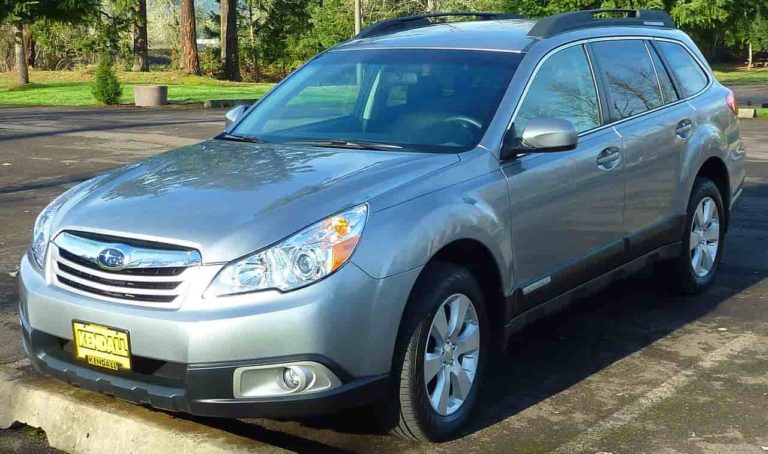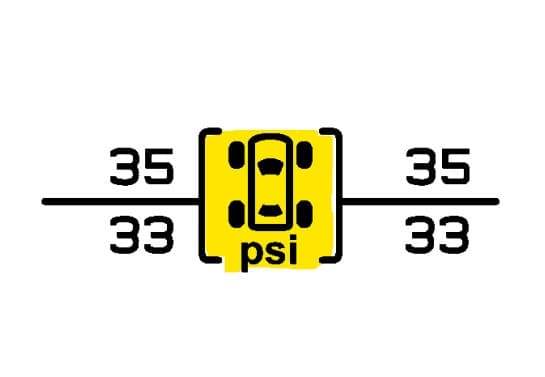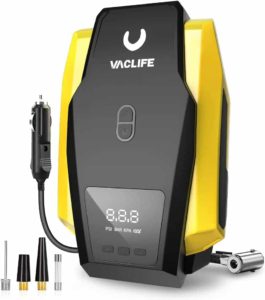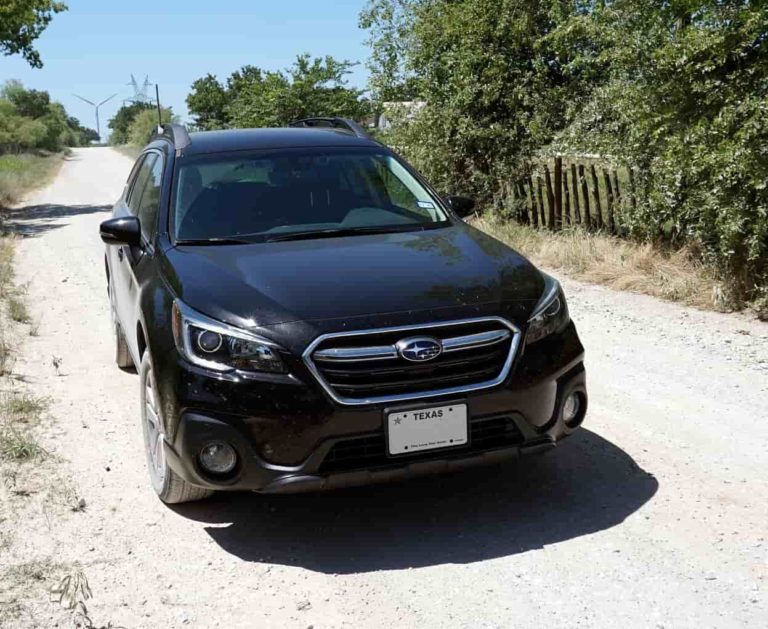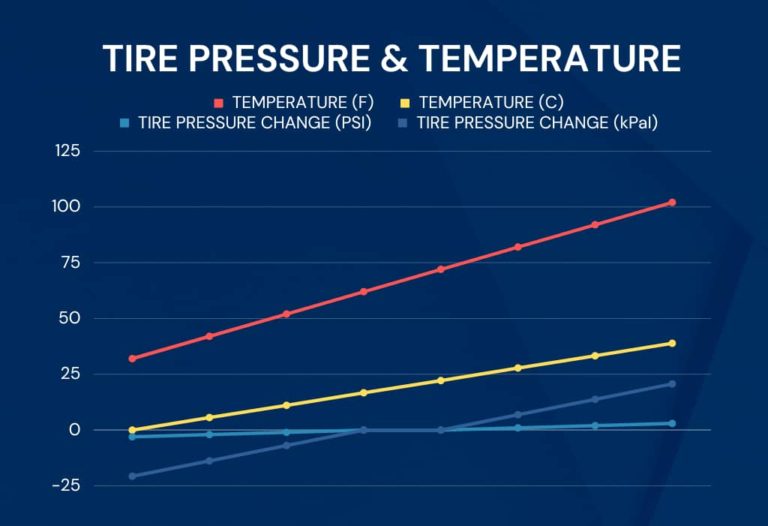No Reset Button
Before we get into specifics, understand that your Subaru Outback doesn’t have a button to reset the tire pressure light. Next, we’ll describe how the tire pressure system operates and give you 9 easy steps to turn off the tire light.
What is the TPMS in the Subaru Outback?
The tire pressure monitoring system (TPMS) in the Subaru Outback is a safety feature designed to inform the driver about the status of the vehicle’s tire pressure. This system constantly monitors the pressure in all tires and alerts the driver when the pressure is not at an optimal level, ensuring a safer and more efficient driving experience. To check your current tire pressure: Find the 3 buttons “i/Set” with the up and down arrow on the bottom left of your steering wheel. Use the top or bottom arrow to scroll through a list of screens until you see the tire pressure screen.
2023 Subaru Outback Tire Pressure and Size
TIRE SIZE | FRONT PSI | REAR PSI |
225/60R18 | 35 | 35 |
225/65R17 | 35 | 35 |
SPARE TIRE | 60 | 60 |
Steps To Reset Subaru Outback Tire Pressure Light
The Subaru Outback does not have a tire pressure reset button.
When the tire pressure light on your dashboard turns on, pull over slowly and check your tire pressure right away.
Figure out which tire is low or high on air and adjust the tire pressure accordingly. (The TPMS lets you know which tire is low on your screen by displaying the low pressure value in yellow instead of white)
Fill your tires to the exact recommended pressures. I cannot emphasize this enough, accuracy is key. 35 Psi.
Drive your Subaru Outback. Drive for 10 or 15 minutes at speeds over 20 Mph.
If the light doesn’t go off right away, re-check your tire pressure to make sure they are all at the exact pressure you set them to. If they are down in pressure, you probably have some sort of tire leak.
If the pressures are at the exact pressure you set them to and the tire light still won’t go off, over fill your tires.
We recommend filling your problem tire with 45 Psi or about 10 Psi over the recommended pressure. With the tire overfilled, drive the car again for another 10 or 15 minutes. This will turn off the tire light.
Now that the tire light is off, readjust the pressure back to the recommended 35 Psi.
One more option, if you followed all these steps and the light is still on (and you don’t have a leak), check your spare tire. Some Subaru’s (depending on the package you have) do have a full size spare with a pressure sensor in them. Make sure your spare tire has 60 Psi. Now drive the car again.
How Does the Subaru Outback TPMS Work?
The Tire Pressure Monitoring System (TPMS) in the Subaru Outback functions as follows:
Sensors: Each tire, including the spare, has a sensor attached to it. (on the inside of the tire, attached to the other end of each tire valve) These sensors monitor the air pressure inside the tires continuously.
Transmission: The sensors send this tire pressure information wirelessly to the TPMS control unit located in the Outback.
Analysis: The control unit analyzes the data received from the sensors. It checks if the tire pressure is within the optimal range set by Subaru.
Dashboard Light: If the control unit detects a tire with pressure below the optimal range, it activates the TPMS warning light on the vehicle’s dashboard. (the yellow exclamation point) This is to alert the driver that at least one tire is underinflated.
System Self-check: Every time you start driving your Subaru Outback it performs a self-check, ensuring that the system is functioning correctly and all sensors are communicating properly.
What is the TPMS Malfunction Indicator?
The Subaru Outback’s tire pressure monitoring system also has a malfunction indicator to alert you when something is wrong with the system itself. This indicator uses the same yellow exclamation point as the low tire pressure light. The difference is that, if there is a problem with the system, the light will flash for approximately 60 seconds before staying on. This flashing or blinking will happen every time you start your car until the issue is resolved. When your tire light is flashing your Outback won’t know if your tires are low on pressure. To summarize, a blinking tire pressure light means there is a malfunction within the TPMS itself, rather than an air pressure issue. This is usually due to a faulty pressure sensor in one of your tires (a dead battery) or driving with the spare tire. (if the spare doesn’t have a sensor in it) To determine which sensor is faulty, use a TPMS diagnostic tool and scan each sensor for diagnostic information.
Why is My Tire Pressure Light On?
What Will Cause the TPMS To Not Work Properly?
Using non Subaru wheels
Using non Subaru tire sizes
If a window tint is installed, this can sometimes affect radio wave signals
If there is a lot of snow or ice on or around the tire valves
If the tire pressure is extremely high
If wheels without tire pressure sensors are installed on the car
If new tire pressure sensors are installed without registering the new sensor IDs with the Outback’s receiver module/ECU.
What Can Cause the Tire Light to Turn On?
Seasonal temperature changes: A drop in ambient temperature can cause tire pressure to decrease, triggering the warning light.
Tire puncture or leak: A sharp object or road debris like a nail or screw may puncture a tire, causing air loss which will of course activate the warning light.
Faulty tire pressure sensor: Damaged or malfunctioning sensors may provide inaccurate readings, resulting in a false alert. The only way to determine which sensor is faulty is to scan each sensor with a TPMS diagnostic tool.
Spare Tire: Driving with the spare tire or donut on your Outback will make your tire light turn on.
Valve stem issues: A damaged or leaking valve stem can lead to gradual pressure loss and eventual activation of the tire pressure light. They make kits to replace the rubber gasket that usually goes bad.
Tire damage: Impact from potholes or hitting a curb can cause structural damage like tire bubbles, leading to pressure loss.
Sensor battery life: TPMS sensors are battery-powered, and over time, batteries die. (they usually last anywhere from 5-10 years) This will cause the tire pressure light to turn on. Again, you must use a diagnostic tool to determine which sensor is dead or dying.
Recent tire rotation or replacement: If the tires have been recently rotated or replaced, the TPMS may need recalibration to avoid false alerts. Sometimes the vehicle’s computer may think the front tires are in the rear and rear in the front after a rotation.
Wheel or rim issues: Damaged, corroded, or cracked wheels or rims can lead to air leaks and pressure loss. This is very common with low profile tires.
Altitude changes: Climbing or descending in elevation can affect tire pressure and trigger the TPMS warning. An additional 1.5 Psi per Km above sea level is required.
Natural pressure loss: Tires lose air pressure over time due to temperature changes and permeation. Tire dry-rot will happen to tires that sit.
Electrical problems or software issues within the car’s TPMS system. Occasionally the system may have a software update from Subaru.
Snow Tires: If you have a separate set of wheels/rims for snow tires, either swap over the sensors from your summer wheels or purchase a second set of 4 sensors for the second set of wheels/rims. If you are using one set of wheels for both sets of tires, do not worry about this.
What Happens When Tires are Underinflated?
Tires that are underinflated can have the following effects:
Increased Wear: Underinflated tires wear out quicker. The outer edges contact the road excessively and wear out faster than the center.
Poor Fuel Efficiency: If the tires are underinflated, the car requires more energy to move, which reduces fuel efficiency.
Heat Build-up: Underinflated tires can build up excessive heat, which can cause the tire to degrade and possibly fail.
Reduced Handling: Underinflation can reduce the car’s handling ability, making it harder to steer, especially at higher speeds.
Decreased Load Capacity: An underinflated tire can’t support as much weight, which can cause the tire to become overloaded.
Increased Chance of Tire and Wheel Damage: Underinflated tires and wheels are more susceptible to damage from potholes and other road hazards.
Possible Tire Blowout: Severe underinflation can lead to tire blowouts, which are dangerous and can cause serious accidents.
What Happens When Tires are Overinflated?
Overinflated tires can lead to the following issues:
Reduced Traction: Overinflated tires have a smaller contact area with the road, which reduces traction and can cause the vehicle to skid or slide, especially in wet conditions.
Increased Wear in the Center: Too much air pressure can cause the center of the tire to bulge out and wear faster than the edges.
Harsher Ride: Overinflated tires don’t absorb road shocks very well. This can result in a rougher ride and could even cause damage to the vehicle’s suspension.
Increased Risk of Punctures and Blowouts: Overinflation makes tires harder and susceptible to damage from potholes, debris, or sharp objects on the road.
Reduced Handling: The vehicle’s handling may become unpredictable and unstable, especially when changing lanes or turning at higher speeds.
Increased Stopping Distance: Overinflated tires can increase the vehicle’s braking distance, which can be dangerous, especially in an emergency situation. This can also increase brake pad and rotor wear.
Does the Weather Impact Tire Pressure?
Weather significantly impacts tire pressure due to the fundamental principle that air expands when heated and contracts when cooled. In warmer conditions, the air inside your tires will expand, potentially causing overinflation. Conversely, during colder seasons, the air contracts, leading to underinflation. For instance, a drop of 10 degrees Fahrenheit can decrease tire pressure by about one psi. This is why it’s important to regularly check tire pressure year-round, and particularly during seasonal transitions!
How to Adjust Tire Pressure
Get a high-quality tire gauge.
Make sure to check the tire pressure when the tires are cold. “Cold” means your vehicle has been sitting for at least three hours or driven less than 1 mile in the past 3 hours.
Take off the valve cap from the tire valve stem.
Push the tire gauge firmly onto the valve to measure the pressure.
Compare the pressure reading with the recommended pressure on the tire information label. 35 Psi in the front and rear tires, 60 Psi in the spare.
If the pressure is lower than the recommended pressure, add air.
If the pressure is too high, let out some air by pressing the metal stem in the center of the tire valve. You can use any object like a screwdriver to do this. Be gentle.
Recheck the tire pressure with the gauge.
Don’t forget to put the valve caps back on to prevent leaks and keep dirt and moisture out.
When Should You Adjust Your Tire Pressure?
To get an accurate measure on your Subaru Outback’s tire pressure, check it when the car hasn’t been used for some time, such as in the morning. (Ideally, it should be parked for about 3 hours.) Tires warm up and the air inside increases when you drive, leading to misleadingly high readings. Therefore, don’t adjust the tire pressure right after driving; otherwise, your tires will be overfilled.
Conclusion
In conclusion, the tire pressure monitoring system in your Subaru Outback is an essential component that ensures your safety on the road. It alerts you to both underinflated and overinflated tires, helping to maintain optimal tire performance and longevity. Remember to adjust your tire pressure as per the weather and driving conditions, ideally when the car has been at rest for a few hours. So, maintain your Outback’s tires well and enjoy safe and efficient driving. Everything in this article is applicable to all Subaru Outback models and trims. Including, Outback Base, Premium, Onyx Edition, Limited, Touring, Onyx Edition XT, Wilderness, Limited XT, Touring XT.
Please note that this blog post contains Amazon affiliate links. This means that if you make a purchase through one of these links, we at TPMSRESET.com may earn a small commission at no extra cost to you. We only recommend products that we personally use and believe in. Thank you for supporting us.

